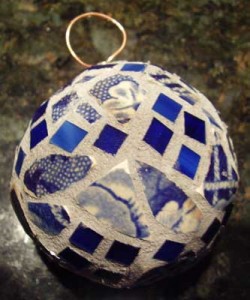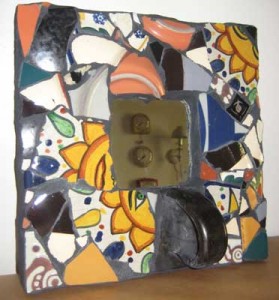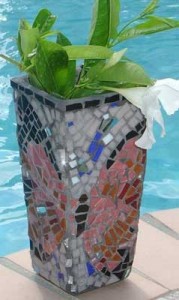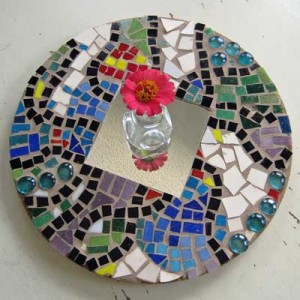Ideas for small mosaic projects for beginners with examples
Mosaic Trivets and Mosaic Plaques
The best beginner’s project is a small trivet or plaque made on 1/2 inch plywood. I recommend cabinet-grade plywood which comes with a sanded finish. Many times you can get plenty of plywood in the scrap bin from a home remodeling job. Note that your backer doesn’t need to be perfectly square. Irregular triangles and rectangles and trapezoids work as well as squares. Remember to be “artistic” and “color outside the lines.”
If you desire to make a mosaic shape like a star or a cat or a sun, then 1/2 inch sanded plywood is still the best way to go. You can buy an entire sheet of plywood and a jigsaw to cut it with for not much more than what most craft websites charge for mosaic backers. Another advantage of cutting your own shape is that your project is more likely to look like YOUR art instead of some factory-made craft kit, which is all I can think of when I see the mosaic shapes or mosaic backers sold elsewhere.
The exposed edges of your plywood backer can be painted with a neutral color of acrylic paint or even latex house paint. You don’t always have to buy something special to make art, and you can often use what you happen to have on hand. In fact, using re-purposed materials usually adds an extra dimension of creativity to your project.
Displaying small mosaic plaques is simple: they can rest on a table as a coaster or trivet to hold hot plates, or they can be displayed on a small plate easel, such as people use to display fine china plates.

Mosaic Christmas ornament by Jim Hopton constructed on a 2.5″ Styrofoam ball using glass mosaic tile and antique china shards found along the shores of the Allegheny River in Pittsburgh, PA. I recommend threading a wire loop all the way through the Styrofoam ball before mosaicing to make sure that the heavy mosaic ornament has something secure to tie the string to. Craft stores sell little hoops with spikes that stick into the Styrofoam less than an inch, but that would not hold a heavier ornament. Our mosaic ornament kit comes built ready to hold the weight of tile and grout.

Mosaic Mirror by Melanie Berry makes use of broken dinnerware and broken talavera tile from Mexico, which is a soft terracotta tile with a colorful glaze of primary colors in traditional patterns. Keep in mind that you can make your own mosaic mirrors from plywood and mirror stock. One sheet of 1/2-inch plywood is used as a backer, and a second of 1/4 inch has a whole cut out for the mirror and forms a frame around the mirror. If this seems like extra work compared to buying something ready made, then remember that making your own allows you to make it exactly the size and shape you want. Tip: you don’t have to own a jigsaw or cut it out yourself. You probably have a friend or a friend’s partner that can do that for you.

Butterfly Mosaic Vase by Sandra Schwartz was made on a thick glass vase. Sandra reports that she coated the vase with Weldbond and allowed that to dry before gluing on tile. This makes the work of gluing on tile much easier because a surface of dried glue is less likely to allow tile to slide compared to a slick glass surface. I would recommend scuffing the glass with coarse-grit sandpaper before applying the first coat of glue.

Mosaic Mirror by Sandra Schwartz is a mixed-media mosaic that uses glass gems, glass mosaic tile and broken dinnerware.